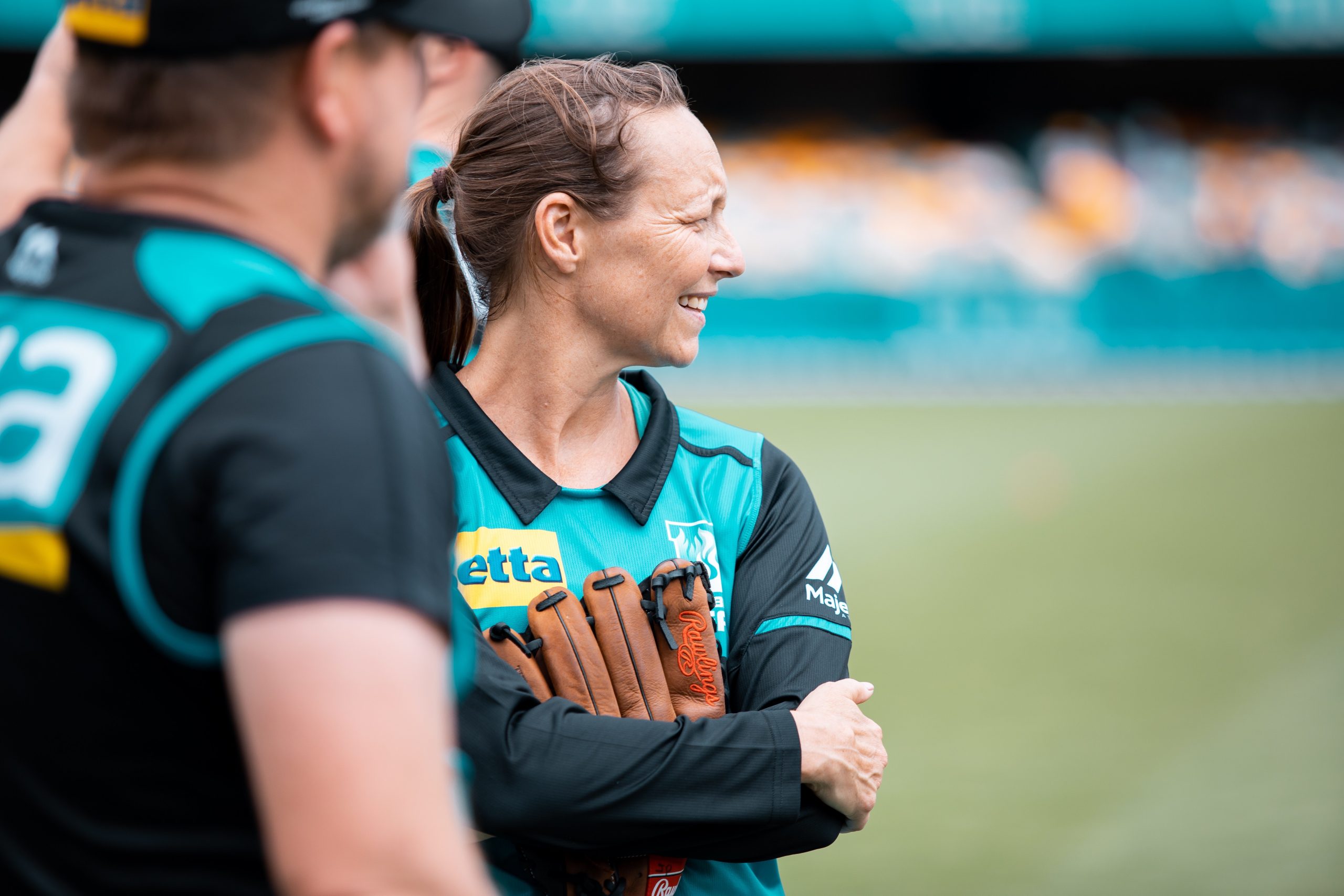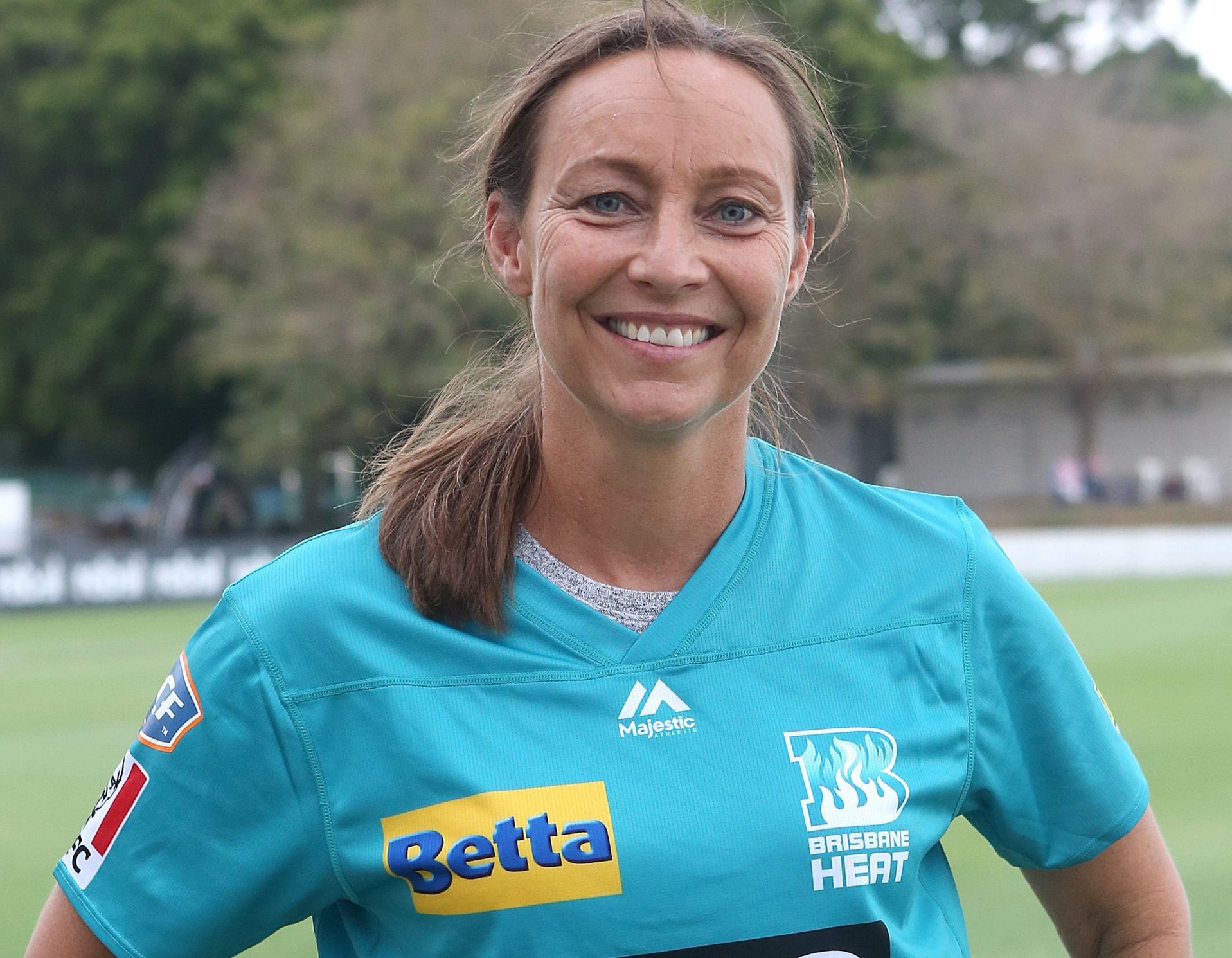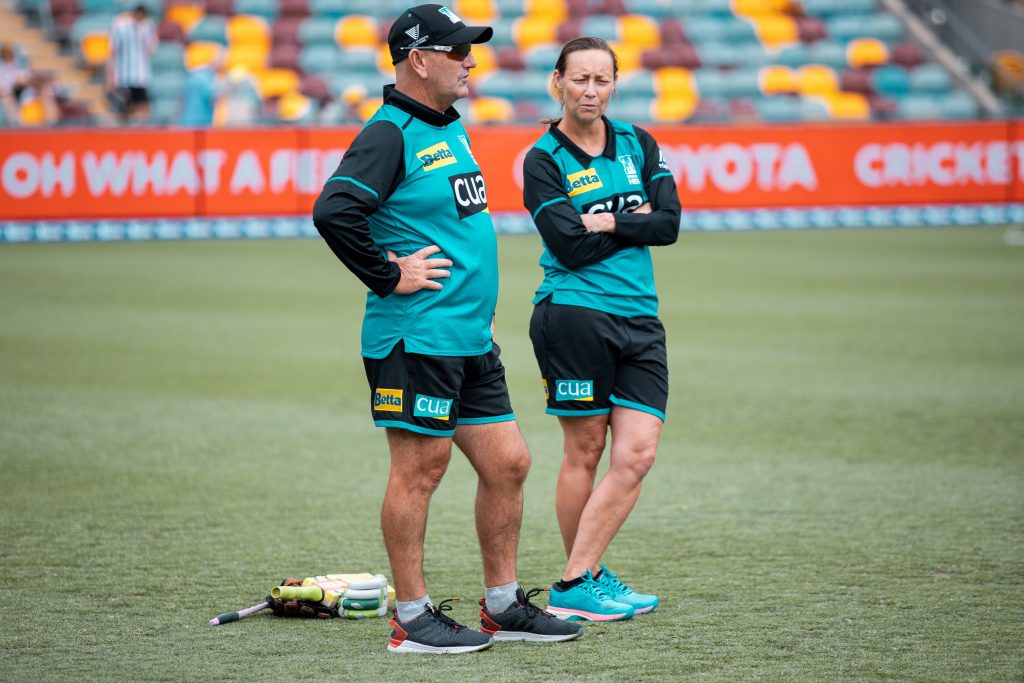Julia Price is currently the coach of the US women’s cricket team and created history by becoming the first-ever female coach in Australia’s Big Bash League (BBL). She also won two World Cups with the Australian Women’s Cricket Team in 1997 and 2005. Her passion for the game has led her into coaching, travelling the world teaching the game, and having a lot of fun while she is at it.
Kinza Tahir caught up with her for this feature on Sportageous to talk about breaking barriers, cricket coaching, her experiences with the sport around the world and the future of the women’s game in Australia and the US.

Kinza Tahir: How would you summarise your cricket career?
Julia Price: It’s been eventful. I finished school by the time I started playing, which is unusual, particularly today. I was pretty lucky to make the Australian team by 23, but at the same time, we were very amateur back when I was playing.
I was very lucky to go through with a group of girls who were unbelievably skilled and talented. I was very lucky to be in that in that sort of timeframe and then with the changes in administration we first had Women’s Cricket Australia, then the Australian Women’s Cricket Council and then finally, we got taken over by Cricket Australia.
We witnessed how the game was changing for female cricket and it was becoming more and more popular. Obviously now it’s fully professional. I then coached here in Tasmania and today, the domestic system is quite professional and the international girls are professional too. It’s just a completely different world but it has been really exciting to see it transition over that period of time in the last 30 years or so.
I think the investment that they’re going to put into the game in America is going to be enormous. At the moment, they’re just restructuring the domestic set up for the women’s side. With the men they’re introducing a minor league and a major league to put it in American terms.
Tell us about your life outside of cricket.
It’s not very interesting. I just do a bit of commentary, which is still about cricket, but I live here in Hobart in Tasmania, so it’s a little quiet, tiny island, at the bottom of Australia, so there’s plenty of bushwalking and I go and see a few live bands every now and then.
I also love a bit of red wine and gin and I absolutely love travel. So they’re sort of my key things. COVID-19 really killed off a few of those things for me, because I haven’t been able to leave the island for six months, let alone travel overseas, but I’ve managed to get in a little bit of red wine and gin. So that part has been good.
You played for Australia, and you went on to win the World Cup in 1997 and 2005, which were career-defining moments. Can you share your experience from that time? As there was a considerable gap between both the wins.
1997 was in India, and that was my second year of playing cricket for Australia. So I was still on a bit of a high. Then, I was astounded and amazed that I was in a team that won the World Cup in my first attempt out, this, of course, is fairly unusual.
It was in front of a huge crowd of 80,000 in Kolkata. The whole experience was fantastic. I think they had about 12 teams in the tournament. It was just an enormous tour and a lot of fun between that 1997 World Cup and the 1998 Ashes tour. My two favourite tours of all time.
We were playing good cricket. You felt like a proper cricketer. You were on TV all the time, travelling and touring and playing game after game in front of huge crowds. It was really fun!
The 2005 World Cup was different for me because I had been dropped in 2003. So I had missed the 2004 season. I was really focused on playing the best that I could in the domestic competition without focusing too much on making that World Cup team but clearly that was my goal.
We are going to see a lot of female cricketers coming through. When I played, I played with Linda Clark, Karen Rolton, Mel Johnson who are legends of the game.
It was very different, as it was more of a relief when I finally got picked for that 2005 World Cup team again, but at the same time, the experience was quite exhausting as I overtrained. By the end of it, I was absolutely copped.
It was when the women started to shift into that slightly more professional way of training and going about things. So I probably didn’t enjoy the World Cup as much as I should have. We won in South Africa and we stayed in a sort of university accommodation.
We were quite restricted about where we could go and as I said, I love travelling and getting out and about, mingling with different cultures, and we weren’t really allowed out into the community.
So it was a very, very sterile World Cup, however, it was fantastic that I was able to be involved in it. It was great as that was one of my goals of trying to get back into that team.
You are currently the head coach of the US women’s cricket team. Tell us about your coaching journey, the transition from playing for Australia and then moving to the US team.
Well, there were a few steps in between all that but while I was playing for Australia, I got my level two [coaching licence] and started doing some additional coaching because it was an easy way of making money as it was hard to have a full-time job and travel as much as we were starting to do in the late 90s and early 2000s for the Australian team.
Also, the domestic competition was getting bigger and bigger as well. I started coaching then and from 2000 to about 2005, I travelled overseas every year and coached in Ireland, the Netherlands and Scotland over that period of time.
Actually, in 1999 I went to South Africa as well and hung out with Mel Jones. She was coaching over there and that’s sort of where the coaching started for me and it was a means to help me make some money.
Secondly, it was great that I could travel and do it and then thirdly, I found that through coaching it actually really helped my game, because I started the game so late it was really a good way of teaching others how to play, but it really helped me reflect on whether I was doing the right things and if I was practising what I was preaching. I began to implement a lot of this on my journey back into the Australian team in 2005.
I continued on with private coaching and I started working in the AFL in Queensland where I was living at the time, and helped develop the women’s football league and ran their high performance in the grassroots football program, but I was still playing grassroots football at the time.
READ: In conversation with Charvi Bhatt: Former captain of the UAE Women’s cricket team
I retired in 2012, had a year off and then I got a call from Tasmania to see if I’d coach them in the domestic league, which was a great opportunity. I did that for five years, which included doing the Women’s Big Bash League (WBBL) with the Hobart Hurricanes as well, until 2018. I had a good relationship with the USA already.
I had done one trip over there just to help out with some talent identification stuff and did it again in 2018 because I had some spare time and I was travelling because I didn’t have a job at that stage and then this opportunity came up.
So it’s just a little bit of case of being in the right place at the right time. It’s a fantastic place though, the potential that they’ve got in America to grow the game and to be amazing cricketers particularly with 330 million people in the country is huge.
They’ve got good potential there to get into the World Cup, at some stage. Not long down the track, hopefully!

You are the first-ever female to be a coach in the BBL. So, tell us how that happened?
I’ve been friends with Darren Lehmann for a while and just through cricket, we crossed over in a few areas and obviously having moved up to Queensland myself, a lot of my friends are friends with him as well.
We were at a barbecue at his house and I mentioned it to him the year before. I just sort of said, “Darren if you ever need an assistant coach, I’m more than happy to help out.” It was very tongue in cheek and a bit of a joke.
Then we started talking about doing some sort of professional development and I thought I will see if there’s any way I can tag along and have a look at how they go about it in the men’s program.
From there, it actually worked its way into becoming an assistant coaching role. So my expectations weren’t that high at all and actually, it got a little intimidating to a degree being the first woman to do so. I wasn’t trying to be the first female to do it. It was again being in the right place at the right time.
It was a fantastic opportunity that the Brisbane Heat gave me. They’re very progressive in their thinking as well. It was a little difficult I suppose, I was mainly just trying to form relationships with the guys.
It’s really difficult to be a coach if you haven’t got a relationship with the players and there needs to be that element of trust between players and a coach and if I just came in there and started doing this they would be like, “who on earth is this?”.
The potential that they’ve got in America to grow the game and to be amazing cricketers particularly with 330 million people in the country is huge.
Probably, for most of the time that I was there, it was more about relationship building. And for them to maybe to see the game from a different perspective which is the female-side, obviously.
Most of them were really open to some really good conversations did not know that some of the rules are different in the women’s game and that the history of the women’s games is quite extensive. Even the way that we interpret the game and look at it from a different perspective, it is so different from how the guys go about their game.
So I think there’s certainly something that girls and females can add to a program at any level whether it be male or female.
How do you think the quality of coaching has developed as the woman’s cricket has grown over the years?
We are going to see a lot of female cricketers coming through. I was really lucky I played with the likes of Linda Clark, Karen Rolton and Mel Johnson who are all legends of the game.
We had a really good coach called John Harmer, who is probably not known to many people, but he was outstanding with the way he went about his coaching. We were also very lucky because we got exposed to an excellent coach. This was at a time when he probably wasn’t getting paid a whole lot of money, which, unfortunately, is what it tends to be about, but with the growth of the game there’s been more investment into the coaching side of things.
Allowing girls to have better access to those coaches, resources, and facilities makes it a much better product and it also makes it easier for girls to be able to improve because they’re in the right environment.
It’s been just over 10 years since international players have started getting paid some reasonable money. When some of those girls start to retire, we’re going to see them take their knowledge and contribute to the mechanism of teaching and coaching. They’ve got so much knowledge about the game, they’ve learned and had so many experiences in different countries and from different coaches.
During COVID, my coaching sort of changed a little bit because we’ve got more time to focus on a lot of the off field stuff and the things that we don’t normally focus on.
Obviously, with the WBBL we’ve got here in Australia, we’ve got plenty of other international players coming over, and that gap between what used to take place in the subcontinent and what was going on here is now getting smaller, because we’ve had all these girls come over to Australia to help share their knowledge, and vice versa.
The subcontinent players are taking skills back there too. So I think the gap is getting smaller and people’s knowledge base is getting broader because they’re getting exposed to so many different types of experiences in the game now. I think this will help enormously with growing the game and that’s with every country and their experiences like the women’s IPL.
When that kicks off, it’s just going to be the icing on the cake. I think that’s the biggie that we’re looking forward to, hopefully, something happening there, but we’ve got so many opportunities for girls to start giving back to the game. It has made a huge difference and it has been a very steep climb as well. It’s not a gradual one.
What is the perception of cricket in the US? How do you see it growing?
It’s not really seen as an American sport quite yet and it’s not in the community as much as it could be. One of the things that USA cricket is definitely working on is how to get it into that community, probably through universities and schools.
There are already a few clubs out there and we’re talking both male and female cricket here. The good thing about cricket in America is that there is not really a difference between the men and womens game. That was the problem in Australia for a long time and probably quite a few other countries.
It was always seen as a men’s game, whereas in America, they just see it as a game. So there’s one stigma that they’ve already gotten over straight away, they don’t have to worry about that sort of thing.
I think the investment that they’re going to put into the game in America is going to be enormous. At the moment, they’re just restructuring the domestic set up for the women’s side. With the men, they’re introducing a minor league and a major league to put it in American terms. This will be very similar to the BBL. And when it’s on TV, that will really get the American public to watch these games and physically go to them, when they’re being played in the country.
It’s very similar to trying to grow the game here in Australia, it was always the idea that you can’t be what you can’t see. We’re using that same sort of slogan to a degree in America and developing countries, ie. making it as accessible as possible to anyone who wants to play and not just to all the expats from the Caribbean or from the subcontinent or Australia that happen to be living in America. We want everyone to be able to play.
How has the pandemic affected your cricket schedule, commitments and routine?
We were supposed to play in the T20 World Cup qualifiers in Sri Lanka in July. I’m not sure how many other countries were but lots of them were affected by it as it then got delayed till November. It’s now been delayed till next year in July.
We’ve had no domestic cricket this year. I haven’t been in the US since December last year. It’s all been zoom and online training. The girls haven’t really played a lot. There are a couple of them in a couple of states at the moment in mixed cricket. They haven’t got any all-female cricket and it does make it very challenging. We’ve had a few girls bowling in the backyard too.
Just trying to be a little bit more innovative about how they’ve gone about their training when they’ve been tested and it has been good. They’ve adapted fairly well and have been flexible with how the training programs are and in cricket, that’s a really good skill to practice as well.
It has messed around with our schedule though and hopefully, we’ll have something coming up pretty soon, depending on COVID, obviously.
At a young age, cricketers tend to play and they ignore their fitness regime. How do you think improvement can be made on the youth level?
I’ve always been big on letting people play lots of sports, particularly as young kids. And to be able to play soccer or football or some game that involve certain levels of fitness alongside cricket.
We do get a bit of bad reputation for not being athletes because there doesn’t appear to be too much running in it, which we know is quite the opposite. But something like football or soccer or other sports, like hockey, have all got a good level of fitness because you have to be running constantly through the game.
I think encouraging kids to have a few different other sports and activities outside of cricket is important. I believe for one that will help with the general fundamental skills that they need, they may then cross over into the sport, but again, it’s also going to get them to do that fitness work and develop a good base level of fitness before they even come onto the cricket scene.
At the same time, you want them to be able to have some sort of self-drive and understanding of doing something that’s going to be cricket related. For me, running between wickets is a big one. If you were to do repeat sprints, or back to back sprints, and that constant load of running hard for long periods of time, as opposed to going for a 10-kilometre run, it is much more worth it. I think that’s probably going to serve you better and it’s much more interesting than going for 10 kilometre runs as well.
Even if it’s not a structured sport that they are playing, for example, if it’s just going for a hike in the mountains or going for a swim or surf. Any sort of physical activity that they enjoy is a great way of getting kids to continue to do this in the long run.
What advice would you give to aspiring and emerging players?
I’d probably say ask lots of questions. Always. I didn’t ask enough as you sort of feel like you’re going to be embarrassed if you don’t know something, but it’s more embarrassing when they find out later that you haven’t known something for so long.
It actually stops your learning ability because you didn’t ask those questions right from the start. Take advantage of any situation that you happen to find yourself in. There’s always a positive in every learning.
Even if you’re failing, you’re learning something in cricket, and you’re going to fail a lot in cricket, everyone does, but at the same time, that’s where you learn the most. You can actually learn how to continue to improve your game, and knowing what your weaknesses are, is a really good way of looking at themselves.
Reflecting on yourself and how you can improve as a person, how you can improve and help improve your team. And that is, again, another thing that is so good about cricket as it’s a very individual sport, but you’ll also be able to use that to play as an individual in a team.
Definitely ask questions and make sure that you take advantage of every situation that you possibly can and see the positives in things.

Are there any other words that you would like to add?
I think a lot of kids always try and specialise a little bit too early or they try and decide that cricket is the only sport for them but like I mentioned before, I think multi-sport is such a valuable way of learning the game or learning lots of different movements and fundamental skills that can be transferrable into cricket or out of cricket.
It also helps to maybe extend your time in cricket. You don’t want to decide at 10 years old that that cricket is the only sport for you, because you might be absolutely bored with it by the time you’re 22 and that’s the end of your career and that would be a shame.
To me, I think just focus on having fun enjoying yourself. Try lots of different things. Yes, you can still focus on cricket but other things can also help with you improving your game of cricket.
Just talking about the game, working on mindfulness working on the gratitude for the opportunities that you’re given, working on meditation, how to relax, and how to even work on your time management, how you are going to fit everything in your day.
If you’re at school, and you’ve got all these exams coming up, how are you going to find time for your cricket programs as well? So, there’s plenty more that you can learn about the game even if it’s not just the physical side of nets and doing fielding, batting and bowling.
That mental side of the game is very, very powerful as well so if anything, COVID has really stretched me in that regard. I think the American girls will be a lot stronger mentally for the upcoming season when we eventually play some cricket.

